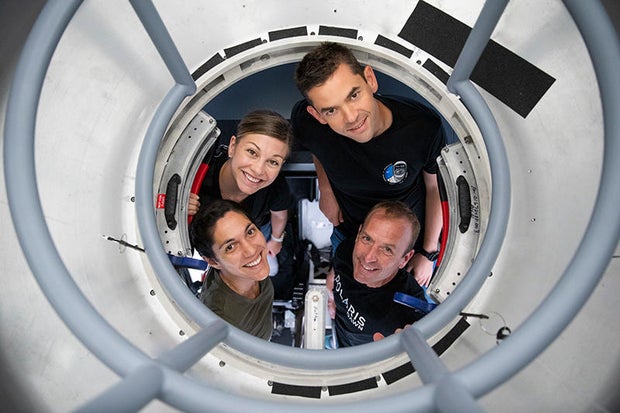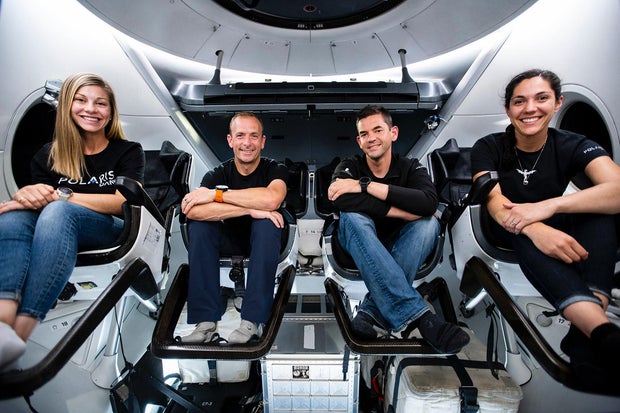CBS News
Polaris Dawn crew gears up for first commercial, non-government spacewalk

Billionaire Jared Isaacman and SpaceX crew trainer Sarah Gillis plan to open the forward hatch of their Polaris Dawn spacecraft early Thursday to take turns floating outside in the first non-government spacewalk in the history of space exploration.
With crewmates Anna Menon and Scott Poteet monitoring safety tethers and umbilicals inside the SpaceX Crew Dragon capsule, Isaacman and Gillis plan to float out into open space after depressurizing the spacecraft around 2:23 a.m. EDT, using a scaffold-like “Skywalker” assembly extending from the hatch for stability.
While their feet will be just outside the hatch, they will not “free float” away from the Crew Dragon. Their SpaceX-designed pressure suits are not equipped with their own oxygen supply or other life support equipment and rely on the 12-foot-long umbilicals to deliver air, power and communications.
SpaceX
As Isaacman and then Gillis float just outside the hatch, they will test the comfort and mobility of their pressurized extra-vehicular activity, or EVA, suits, moving their arms, hands and legs through a series of positions to find out how much effort is required to carry out basic tasks.
“We’re going to make use of various mobility aids the SpaceX team has engineered, and it’ll look like we’re doing a little bit of a dance,” Isaacman said before launch. “The idea is to learn as much as we possibly can about this suit and get it back to the engineers to inform future suit design evolutions.”
Cameras mounted inside and outside the Crew Dragon, along with others attached to the spacewalkers’ suits, are expected to provide spectacular views of space and the Earth below as the ship sails through an elliptical orbit with a low point of 121 miles and a high point of 458 miles — 200 miles higher than the International Space Station.
The goal of the exercise is to eventually perfect low-cost, easy-to-manufacture spacesuits for use by future commercial astronauts flying to the moon or Mars aboard SpaceX Super Heavy-Starship rockets.
“I think that this journey of creating affordable EVA suits that can be scaled up into mass production is a very worthwhile one,” said Isaacman, who chartered SpaceX’s first fully commercial flight to orbit in 2021. “There’s going to be an armada of Starships arriving on Mars at some point in the future, and those people are going to have to be able to get out of it and walk around and and do important things.”
Isaacman, Poteet, Menon and Gillis blasted off Tuesday from the Kennedy Space Center atop a SpaceX Falcon 9 rocket. The crew accomplished the first major goal of the flight right off the bat, climbing to an altitude of 870 miles — higher than any piloted spacecraft since the Apollo moon program 60 years ago.
The high point, or apogee, of the orbit then was lowered to 458 miles for the spacewalk and the remainder of the five-day mission.
To prevent decompression sickness, also known as the bends, during the crew’s transition from sea-level pressure to the reduced 5 psi pressure in their spacesuits and back, flight controllers began a 45-hour process shortly after launch to boost oxygen levels in the cabin while slowly decreasing air pressure to help remove nitrogen from the crew’s bloodstreams.
“We don’t anticipate experiencing (the bends), because a ton of robust preparation has gone into developing this pre-breathe protocol, significantly reducing that risk,” said Menon, a former biomedical flight controller for NASA. “But we’re prepared if we need it.”
SpaceX
The Crew Dragon does not have an airlock and its life support system was not designed to support spacewalks. Required modifications included “adding a lot more oxygen to the spacecraft so that we can feed oxygen to four suits through umbilicals for the full duration of the spacewalk,” Gillis said.
“There have been upgrades and additions to the environmental sensing suite in the spacecraft to make sure we have really good insight, both before, during and after exposure to vacuum. And … an entirely new system, a nitrogen repress system” to boost the cabin back up to normal pressure after the spacewalk.
Along with the Skywalker scaffold, which extends just beyond the forward hatch, a motor drive system was added to assist with hatch opening and closing and upgraded seals were put in place to ensure an airtight fit.
NASA astronaut Ed White carried out the first U.S. spacewalk on June 3, 1965, floating free of his Gemini 4 capsule at the end of a long tether. Since then, NASA astronauts, Russian cosmonauts, Chinese taikonauts and astronauts from space station partner nations have carried out more than 470 government-sponsored spacewalks.
Isaacman said iconic photos of White floating outside his Gemini capsule against the backdrop of Earth and space were inspirational, but he and Gillis ruled out floating free of the Crew Dragon. And that’s by design.
“We’re not going to be doing the Ed White float,” Isaacman told CBS News before launch. “That might look cool, but it doesn’t really help SpaceX learn a lot about the performance (of the spacesuit). It’s not very useful or helpful for figuring out how to be able to to work in a suit.”
To that end, he and Gillis will work through a “matrix” of planned motions to get a feel for how the suit’s multiple joints move while pressurized, to test the performance of an innovative heads-up display in the helmet, better understand how the air-cooled suits deal with the extreme temperatures of space and a variety of other factors.
SpaceX
The suit “includes all sorts of technology, including a heads-up display, a helmet camera, an entirely new architecture for joint mobility,” Gillis said. “There’s thermal insulation throughout the suit, including a copper and indium tin oxide visor that both provides thermal protection and solar protection.”
In addition, she said, “there’s all sorts of redundancy, both in the oxygen supply feed to the suit, as well as all of the valves, all of the seals across the suit. It’s an incredible suit.”
The heads-up display, which will project critical data on the lower left side of the helmet visor, is a feature NASA’s decades old space station suits do not have.
“During the EVA, we’ll have insight into our suit, pressure, temperature, relative humidity and then also an understanding of how much oxygen we’ve used throughout the EVA. So some key pieces of telemetry right there. And it’s it’s really cool (that) with any lighting you can still see it.”
The Polaris Dawn mission is the first of three planned by Isaacman in cooperation with Musk. The second flight will be another Crew Dragon mission while the third will be the first piloted flight of SpaceX’s huge Super Heavy-Starship rocket, now under development in Texas.
It’s not known how much Isaacman is paying for the flights or how much SpaceX funded on its own. Asked if he could share any details, the entrepreneur, jet pilot and adventurer said “not a chance.”
The mission, SpaceX’s fifth commercial Crew Dragon flight to orbit and its 14th including NASA flights, is expected to last five days, ending with splashdown off the coast of Florida.
CBS News
A Moment With: Antonio Berga and Carlos Serrano

Watch CBS News
Be the first to know
Get browser notifications for breaking news, live events, and exclusive reporting.
CBS News
Yellowstone hiker burned when she falls into scalding water near Old Faithful, park officials say

Yellowstone National Park, Wyo. — A New Hampshire woman suffered severe burns on her leg after hiking off-trail in Yellowstone National Park and falling into scalding water in a thermal area near the Old Faithful geyser, park officials said.
The 60-year-old woman from Windsor, New Hampshire, along with her husband and their leashed dog were walking off a designated trail near the Mallard Lake Trailhead on Monday afternoon when she broke through a thin crust over the water and suffered second- and third-degree burns to her lower leg, park officials said. Her husband and the dog weren’t injured.
The woman was flown to Eastern Idaho Regional Medical Center in Idaho Falls, Idaho for treatment.
National Park Service / Jacob W. Frank
Park visitors are reminded to stay on boardwalks and trails in hydrothermal areas and exercise extreme caution. The ground in those areas is fragile and thin and there’s scalding water just below the surface, park officials said.
Pets are allowed in limited, developed areas of Yellowstone park but are prohibited on boardwalks, hiking trails, in the backcountry and in thermal areas.
The incident is under investigation. The woman’s name wasn’t made public.
This is the first known thermal injury in Yellowstone in 2024, park officials said in a statement. The park had recorded 3.5 million visitors through August this year.
Hot springs have injured and killed more people in Yellowstone National Park than any other natural feature, the National Park Service said. At least 22 people have died from hot spring-related injuries in and around the 3,471-square-mile national park since 1890, park officials have said.
CBS News
LaMonica McIver wins special House election in New Jersey for late Donald Payne Jr.’s seat

TRENTON, N.J. — Democratic Newark City Council President LaMonica McIver has defeated Republican small businessman Carmen Bucco in a contest in New Jersey’s 10th Congressional District that opened up because of the death of Rep. Donald Payne Jr. in April.
McIver will serve out the remainder of Payne’s term, which ends in January. She and Bucco will face a rematch on the November ballot for the full term.
McIver said in a statement Wednesday that she stands on the “shoulders of giants,” naming Payne as chief among them.
She cast ahead to the November election, saying the right to make reproductive health choices was on the ballot as well as whether the economy should benefit the wealthy or “hard working Americans.”
“I will fight because the purpose of politics and the purpose of our vote is to give the people of our communities and our nation a bold voice,” she said.
Bucco congratulated McIver on the victory in a statement but said he’s looking forward to the rematch in November.
“I am not going anywhere,” he said in an email. “We still have a second chance to make district 10 great again!”
Who are LaMonica McIver and Carmen Bucco?
McIver emerged as the Democratic candidate in a crowded field in the July special election. A member of the city council of New Jersey’s biggest city since 2018, she also worked for Montclair Public Schools as a personnel director and plans to focus on affordability, infrastructure, abortion rights and “protecting our democracy,” she told The Associated Press earlier this summer.
Bucco describes himself on his campaign website as a small-business owner influenced by his upbringing in the foster system. He lists support for law enforcement and ending corruption as top issues.
The 10th District lies in a heavily Democratic and majority-Black region of northern New Jersey. Republicans are outnumbered by more than 6 to 1.
It’s been a volatile year for Democrats in New Jersey, where the party dominates state government and the congressional delegation.
Among the developments were the conviction on federal bribery charges of U.S. Sen. Bob Menendez, who has denied the charges, and the demise of the so-called county party line — a system in which local political leaders give their preferred candidates favorable position on the primary ballot.
Democratic Rep. Andy Kim, who’s running for Menendez’s seat, and other Democrats brought a federal lawsuit challenging the practice as part of his campaign to oust Menendez, who has resigned since his conviction.











